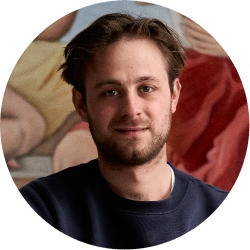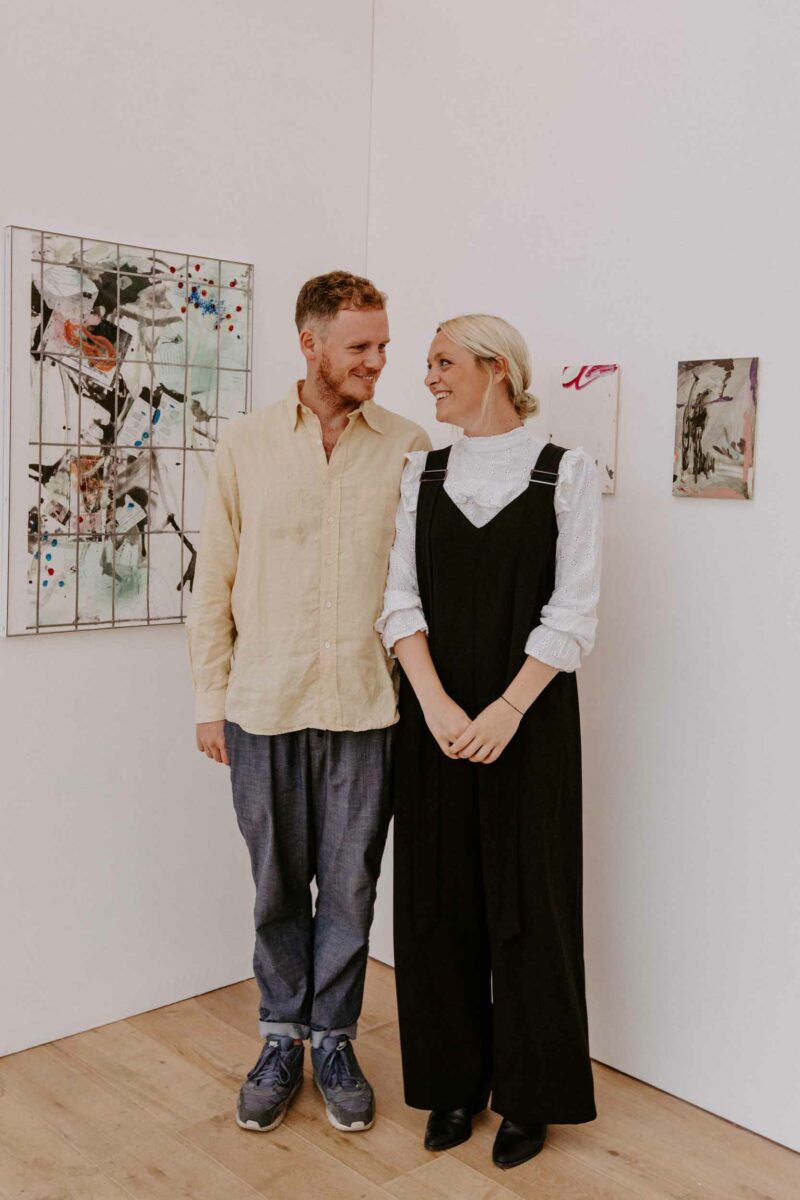And Charlie, were you painting from the get-go?
Charlie: I’ve painted and drawn for as long as I can remember. I also grew up in London, and then went to art school and university in Edinburgh. After that I came back to London, and went to the Royal Academy Schools, and have kept up a studio practice since then.
Was there any one piece of art, or a show you saw, that made it clear that this was what you needed to do?
Charlie: When I was growing up, my parents had this small collection of Cruikshank prints, and they always fascinated me — they now hang in our flat. Later, when I was at Edinburgh University, I think it was around 2004, I came down to London to see a Philip Guston show at the Royal Academy, which they had put on in conjunction with a Edouard Vuillard show. They were both incredible and the two shows together really stuck with me.
Sid: The annoying answer is “lots.” When I was younger, there were lots of experiences that I can remember very vividly in galleries, where I thought, “there’s something about this that is just magic.”
Sid, can you talk about the challenges of launching your own space?
Sid: The first six years I worked on my own. I had to ask myself really carefully what my intentions were, and very quickly it became clear that I wanted to make a space that was accessible to people. I wanted that to be in terms of having a friendly face that answers the door, but also in terms of price point. For collectors, or one-day collectors, to walk in and realize they can establish a relationship with the gallery, and that there can be a range of prices that are within reach of them felt very important.
So, how did you two meet?
Charlie: We first met in Basel. I was showing some paintings at Liste…
Sid: I remember walking into the fair and seeing Charlie’s work, and being like “Hey, Charlie’s on show,” because I had already seen his work, so when we met at a gallery dinner that night I was happy to meet in person!
Charlie: And luckily back in London a few years later, we met again at the Royal Academy auction and dinner!
And what led you to South Bermondsey?
Charlie: Towards the end of my time at the RA, I started to look around for affordable commercial space where I could work. The nicest spaces that I could find at the time were in South London, and I finally found this building — The Penarth Centre. There were quite a lot of empty units then, but there weren’t many studios. After I’d been there for a few years, I helped introduce some people to the landlord and now there are quite a lot of artists and designers working in the building. There are also rehearsal spaces, and two theaters as well.
Sid: And now an art framer, a book publisher — the community is growing and strengthening all the time.
What has been the best part of running a gallery in this specific neighborhood?
Sid: In this building alone there is a really interesting community of artists. So it feels really exciting to bring in a commercial gallery that has these ideas about community, accessibility, and bridging the gap between the exhibiting world and the practicing world.
Together, you organize the South Bermondsey Art Trail. Can you describe how it came into being?
Sid: It was one of the things that Charlie and I arranged when the gallery first moved in. And it was really to prove that there was this amazing community of artists living and working here. One weekend a year, we encourage people to have open studios, to put on special exhibitions, screenings, performances, parties, whatever they want. And this August, it ran for the fourth year. We’ve had a really brilliant uptake of artists — some years there’s been up to 70 artists involved in one way or the other — and we intentionally keep it super local: literally the surrounding streets of where we are.
Charlie: As long as they are a creative person working in the local area, then they can be included.
As a painter, what’s it like working in such close proximity to so many other artists?
Charlie: I’m an artist who really enjoys working on my own. I’ve set my studio up as a private space that I enjoy working in, without any distractions. But I also love inviting people into the space to talk to them when I’m not painting. The Art Trail works really well for me because it means that I can have great conversations with other artists, in my studio and in other people’s studios. And then when I’m wanting to work, I can be on my own.
Sid: I think it’s fair to say that the most rewarding thing about the Art Trail has been that it allows local artists to meet each other. To have an opportunity to step into each other’s studios, you know, have the door open and talk about their practice. It’s just been so rewarding for us, how many great relationships they’ve been able to establish between themselves, because of this opportunity to do it.
Is there any kind of overarching ethos that brings people together in South Bermondsey?
Charlie: There’s just a lot of variety, which is really healthy. People have just found their way here, and are working in all different kinds of ways…
Sid: …and are meeting and sharing ideas. But also sharing resources, sharing tools. I mean, it’s not unusual that you’ll get a message to say there’s leftover materials, or someone’s looking for a specialist kind of drill bit…
Charlie: …and there’s a lot of great fabricators. There are really good metal workers, powder coaters, laser cutters, stone workers. All the things that artists might need.
What is the relationship like with your neighbors, most of whom are industrial manufacturers and the like? Are they happy to see artists moving in?
Charlie: We’ve always gotten along really well with them, the businesses around here, some of whom do actually work with artists, though perhaps not as their main business. The stonecutters have done projects for artists, and a lot of the metal fabricators do quite a lot of fabrication for artists, and the powder coaters as well. I think they like having artists around.
Sid: From my window at the gallery. I can look into the metal workshop opposite me. The last Southwark Park Galleries show was all fabricated there. To be able to stand up from my desk, and see the pieces of an exhibition that I later go to see, is great fun. I can’t, as a Londoner, think of anywhere else where that’s really possible.
Do you have any favorite spots in the neighborhood?
Charlie: There are lots of really good parks around. Southwark Park’s not very far, which obviously has the Southwark Park Galleries in it, and Deptford Park and Folkestone Gardens as well are also really close. And there’s a really nice cafe in Folkestone Gardens where Sid had a gallery dinner last week. Just down the road, there’s Goldsmiths CCA, which always has amazing exhibitions on, and a great cafe as well.
What do like to do when you’re not painting and running the gallery?
Charlie: We often visit my parents in Sussex, it’s really nice to get out into a very rural part of the country. But we also love going to exhibitions, museums, and concerts.
Sid: On Monday night we went to the opening of the Cezanne at the Tate Modern, which we were both completely blown away by. Some really surprising, unusual things there. But the truthful answer to the question is that we’re here mainly six days a week…
Finally, you’re expecting a baby girl in December: congratulations!
Sid: Life’s going to be kind of different. But because our lives and our work are so intertwined, starting a family that can be integrated with life at the gallery and Charlie’s studio feels really exciting. It strengthens the idea that community and friends and life can play into the gallery, and the discourse around making new work. She’s certainly going to be subjected to a lot of exhibitions!
Charlie: It’s going to be a really exciting new chapter for us, and we look forward to introducing her to everyone!

